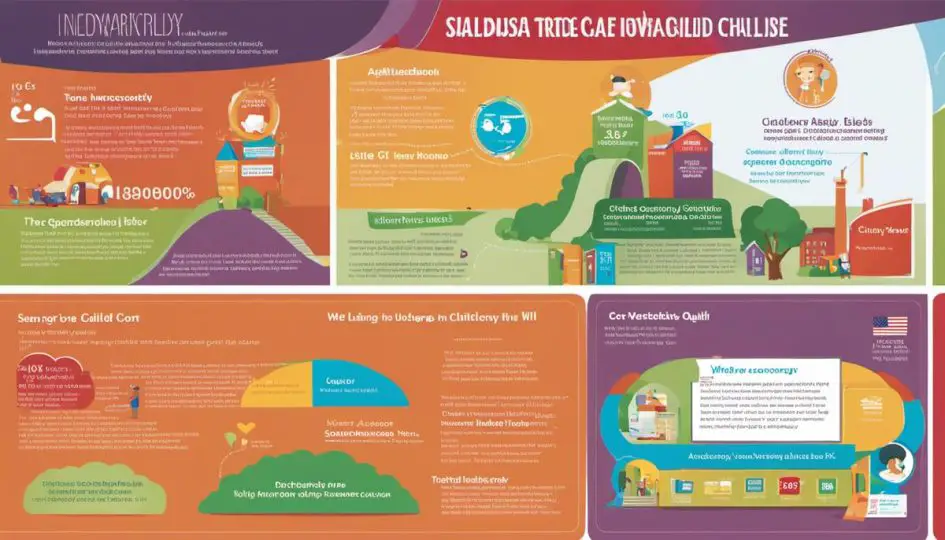As we navigate the realities of the 21st century, with its varying societal demands and patterns, one of our greatest shared concerns lies in the state of childcare in the United States. The current childcare landscape in America presents complex and deeply interwoven issues with far-reaching implications. These issues are set against factors such as high costs, a lack of accessibility, and varying quality, which collectively define the current scenario of childcare. It is imperative to delve deeper into these issues, studying the impacts on families, society at large, and discerning the robust strategies that might help us progressively address them.
Understanding the State of Childcare in the U.S.
The Cost of Childcare in the U.S.
Childcare in the United States is notoriously expensive, often costing more than in-state college tuition. According to the Economic Policy Institute, the annual cost of infant care in the U.S. is $11,896 for a center-based childcare program, and it could rise depending on the location and the quality of the program. In 33 states, infant care costs exceed the average cost of in-state college tuition.
Childcare Accessibility in the U.S.
The cost of childcare has created a barrier in accessibility. Many low-income families struggle to afford this service, which has led to a growing gap in developmental outcomes between high- and low-income children. The Center for American Progress reported in 2018 that 51% of Americans live in areas defined as ‘childcare deserts,’ where there are three children under the age of five for every available childcare slot.
In addition to the cost and availability, scheduling conflicts also impact access to childcare. Many childcare centers operate within traditional working hours, leaving parents who work non-standard or irregular hours without proper care options.
Quality of Childcare in the U.S.
Concerns over childcare don’t stop at cost and accessibility; quality is a significant issue as well. According to the National Institute of Child Health and Human Development, only 10% of child care programs offer high-quality care. When it comes to the early development of children, the quality of the childcare environment is crucial. A poor quality childcare setting can lead to negative outcomes such as behavioral problems and slowed cognitive development.
Understanding Childcare Challenges in the U.S.
The significance of childcare problems lies in their pervasiveness and their potential to impact children, families, and society as a whole. A key issue is the steep cost of childcare in the U.S., rendering it unaffordable for many families. This dearth of affordable solutions often inhibits parents, particularly mothers, from contributing to the workforce and perpetuates economic disparity.
Beyond financial implications, another contributing factor is the gap between the availability of quality care and aligning it with parents’ work schedules. Substandard care can impair a child’s early development, leading to long-term effects on academic performance and broader life achievements.
Highlighting these problems underscores the need for resolutions that take into account not only economic dynamics but also cultural and societal facets. Such solutions aim to provide high-quality, affordable, and accessible childcare to support parents’ workforce participation and enhance overall economic productivity. Additionally, they play a role in leveling the academic playing field early on, reducing achievement gaps, and breaking cycles of intergenerational poverty, therefore fostering a more equal society.

Factors Contributing to Childcare Problems
The Mounting Affordability Challenge in Childcare
The soaring price tag attached to childcare is a significant driving force behind the issues plaguing this sector in the United States. In many urban areas across the nation, the median cost of daycare exceeds the cost of in-state college tuition, posing a colossal financial burden. By making quality childcare inaccessible for many, these significant costs raise questions about the future of early education and the safeguarding of children during working hours. When viewed in line with stagnant wages and a constantly inflating cost of living, these exponential childcare costs are an insurmountable hurdle for families, which could potentially impact the economic prosperity of future generations.
Changing Family Dynamics
Changes to the traditional family structure also contribute to childcare issues. The increase in single-parent households, dual-income families, and non-traditional work schedules often makes finding quality, affordable, and flexible childcare more difficult. With fewer parents at home and less free time overall, families are often left scrambling to find suitable options for their children. This might mean relying on unconventional and inconsistent childcare solutions that could have adverse effects on the child’s development.
Inadequate Government Policies
While there are various governmental facilities that provide childcare options, oftentimes, they are insufficient. Policies and programs often do not meet the demand, leaving many children without access to affordable, quality care. Furthermore, regulations can unintentionally lead to increased costs without necessarily promoting higher quality care. Ultimately, a lack of responsive policies exacerbates the problem, creating an unrealistic expectation for working families trying to balance work and child-rearing responsibilities.
Lack of Trained Childcare Professionals
The United States faces a shortage of trained and qualified childcare professionals. Despite the vitally important job they undertake, childcare workers are often underpaid, leading to high turnover rates and inconsistent care. This not only results in a lack of continuity in care for the child but also creates a shortage in the number of available care spaces, compounding the existing challenges in affordability and accessibility. The shortage also undermines attempts to provide high-quality care that would help children develop their full potential.
Impact of Covid-19 Pandemic
The Covid-19 pandemic has highlighted and exasperated existing childcare issues. With school closures and remote learning, families have been forced into a juggling act between work and childcare, often without suitable relief or support. Additionally, many childcare services have struggled to stay open due to health concerns and financial difficulties, leading to even fewer options for families. The pandemic’s impact has shown the absolute need for comprehensive, accessible, and sustainable childcare solutions.
Proper understanding and identification of childcare issues is the crux on which effective policies and changes hinge. It’s only after we dig deep to comprehend the determining factors contributing to these problems can we begin to devise robust and lasting solutions. Solutions that are not only able to address the immediate childcare dilemmas but also promote the overall well-being of the child, encompassing their mental, emotional, and physical development.

Impacts of Childcare Problems on Families and Society
The Economic Impact of Childcare Concerns
The negative pangs of childcare issues aren’t solely felt in the context of child development but also in terms of a major financial strain on families. Sustaining quality childcare often becomes a tightrope walk for parents or guardians who are already wrestling with other financial commitments like mortgages, car finances, groceries, or health expenses. The enormity of childcare costs can, in certain instances, overshadow even the tuition fees for an in-state public university. It’s a predicament not limited to low-income households, even middle-income families grapple with the escalating childcare expenses.
Rooted in the spiraling childcare costs is the problem of one parent, typically the mother, bowing out from the workforce to take up the reins of round-the-clock childcare. The implications of such a decision are multifold – there’s an immediate dip in the family income and a disruption in the career trajectory of the said parent. In the long run, this could translate into reduced income potential and a subsequent shrinkage in retirement savings.
Socioeconomic Inequalities Due to Childcare Problems
The financial struggles related to childcare are largely borne by lower-income families. Affordable, high-quality childcare is often out of reach for these families, forcing them to settle for less desirable care options or forgoing work altogether to care for their children. This perpetuates a cycle of poverty and closes off opportunities for upward mobility.
In addition to this, the inability to access quality childcare can have lasting impacts on a child’s development and their chances for success later in life. Children who receive quality early childhood education are more likely to perform better academically, have higher incomes, and experience improved health outcomes. Those who do not have access to quality childcare miss out on these potential benefits, further widening the gap between the haves and have-nots.
Childcare Problems and the Wider Society
Childcare problems have ripple effects that extend beyond individual families to the broader society. These problems place a strain on employers because when employees struggle to arrange reliable childcare, they are more likely to be late, miss work, or even leave their jobs entirely. This can contribute to lower productivity, higher recruitment and training costs, and diminished competitive advantage for businesses.
In a broader sense, the scarcity and high cost of quality childcare can also impede economic growth. When access to quality childcare is limited, parents are less likely to participate in the labor market, which narrows the talent pool available to employers and limits economic potential on a larger scale.
Lastly, childcare issues can also impact societal stability. With the increased stress and financial burden that inadequate childcare places on families, problems such as strained relationships, mental health issues, and increased family conflict can become prevalent, leading to societal instability.
It is decidedly apparent that a significant societal demand exists for the establishment of policies and measures that enhance the accessibility of affordable, quality childcare. By addressing this pressing issue, we can alleviate the substantial financial strain placed on families, boost the outcomes for children, fortify the economy and foster a society that is more stable and equitable.

Possible Solutions and Strategies to Address Childcare Problems
Addressing Childcare Issues through Government Policies
Government services and regulations hold a distinct role in alleviating childcare difficulties. The enactment of laws ensuring affordable childcare – through means such as subsidies and vouchers – can notably alleviate financial strain facing families. Legislation such as the Child Care and Development Block Grant (CCDBG) exemplify such provisions, as it provides funding to assist low-income families attain childcare.
These policies also target the betterment of childcare service quality. For instance, the Head Start initiative offers a complete range of early learning and health services to children hailing from low-income families. Efficient implementation of these programs has a significant role in addressing childcare challenges.
Moreover, the reform of existing policies in light of the current childcare crisis could also prove beneficial. Actions such as updating income eligibility criteria, simplifying application procedures, and improving outreach efforts stand to augment the effectiveness of such provisions.
Innovative Business Models as a Solution to Childcare Problems
The private sector and entrepreneurship can provide innovative and efficient solutions to childcare problems. New business models are stepping in to fill the gaps and make quality childcare more affordable and accessible.
One such approach involves employers taking a crucial role in providing childcare for their employees. Employers can subsidize on-site daycare facilities or collaborate with local childcare providers, making it easier for parents to access reliable, high-quality care. Tech companies like Google and Patagonia have adopted such strategies, setting a precedent for other industries.
Another strategy is the emergence of childcare start-ups that rely heavily on technology. They make use of digital platforms to connect parents with childcare providers, babysitters, and nannies. The flexibility and convenience they demonstrate are rapidly turning these platforms into suitable alternatives to traditional childcare measures.
A successful business model, however, relies heavily upon other factors like a supportive regulatory environment, access to capital, and a robust workforce.
Community Cooperative Systems: A Micro-Level Approach to Childcare Problems
Community cooperative systems are another potential solution for childcare problems. In such structures, parents collectively manage and operate childcare centers – sharing duties, costs, and decision-making authority.
These cooperative nursery schools or parent co-ops offer an affordable alternative, as parents’ contribution helps reduce operational costs. Moreover, in parent co-ops, children get individualized attention, making such space a conducive learning environment.
Community childcare cooperatives also foster a sense of community, encouraging parents to actively participate in their children’s early education and development. However, to work optimally, these cooperatives require mutual trust, shared responsibilities, and effective coordination among the participating families.
Summing Up the Strategy
Addressing the childcare crisis requires a multifaceted approach combining effective government policies, innovative business practices and leveraging community resources. This multifaceted approach should ensure the accessibility, affordability, and quality of childcare services, thereby providing a justified solution to the childcare problem.

Our society thrives on the belief that every child deserves access to quality childcare, irrespective of socio-economic factors. However, the current state of childcare in the U.S indicates that we have yet to achieve this goal. By identifying the key factors contributing to childcare issues and understanding the far-reaching impacts, we’re one step closer to finding viable solutions. This calls for innovative thinking and concerted effort from individuals, communities, and the government. Adoption of new government policies, innovative business models, and community cooperative systems could prove to be an effective plan of action. As we press ahead in this century of staggering potential and possibilities, our collective will and determination can steer us towards a future where quality childcare is a norm, not an exception.


Recent Comments